Designing Effective Nursing Care Priorities: A Case Study of Mrs. Amalie Jones
VerifiedAdded on 2023/06/14
|12
|2833
|233
AI Summary
This article discusses how to design effective nursing care priorities for patients with co-morbid health conditions using evidence-based approaches. It includes a case study of Mrs. Amalie Jones and explains how to identify nursing care priorities, set goals, and evaluate outcomes. The article also covers the use of the clinical reasoning cycle and Miller’s functional consequences theory in nursing care.
Contribute Materials
Your contribution can guide someone’s learning journey. Share your
documents today.
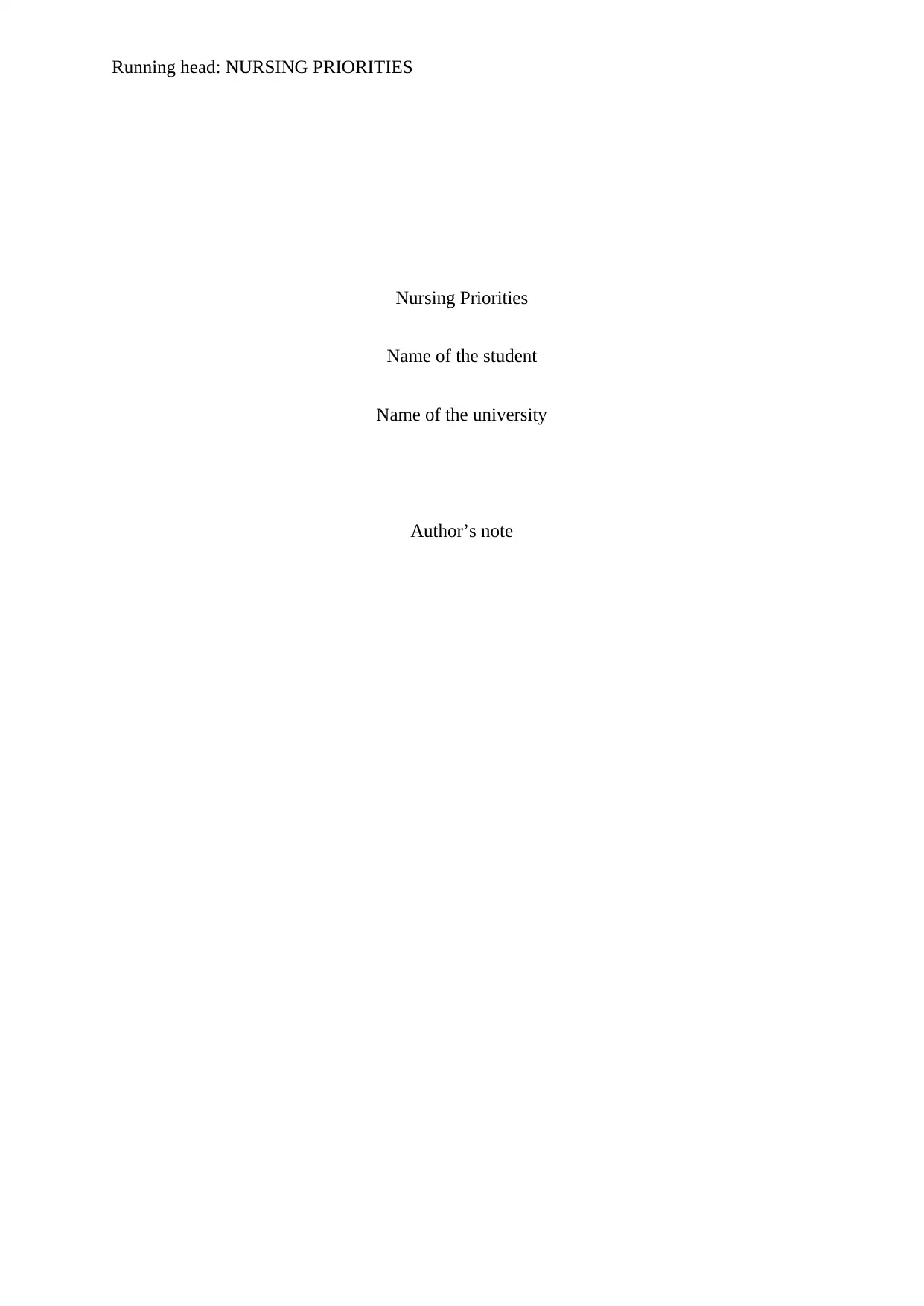
Running head: NURSING PRIORITIES
Nursing Priorities
Name of the student
Name of the university
Author’s note
Nursing Priorities
Name of the student
Name of the university
Author’s note
Secure Best Marks with AI Grader
Need help grading? Try our AI Grader for instant feedback on your assignments.
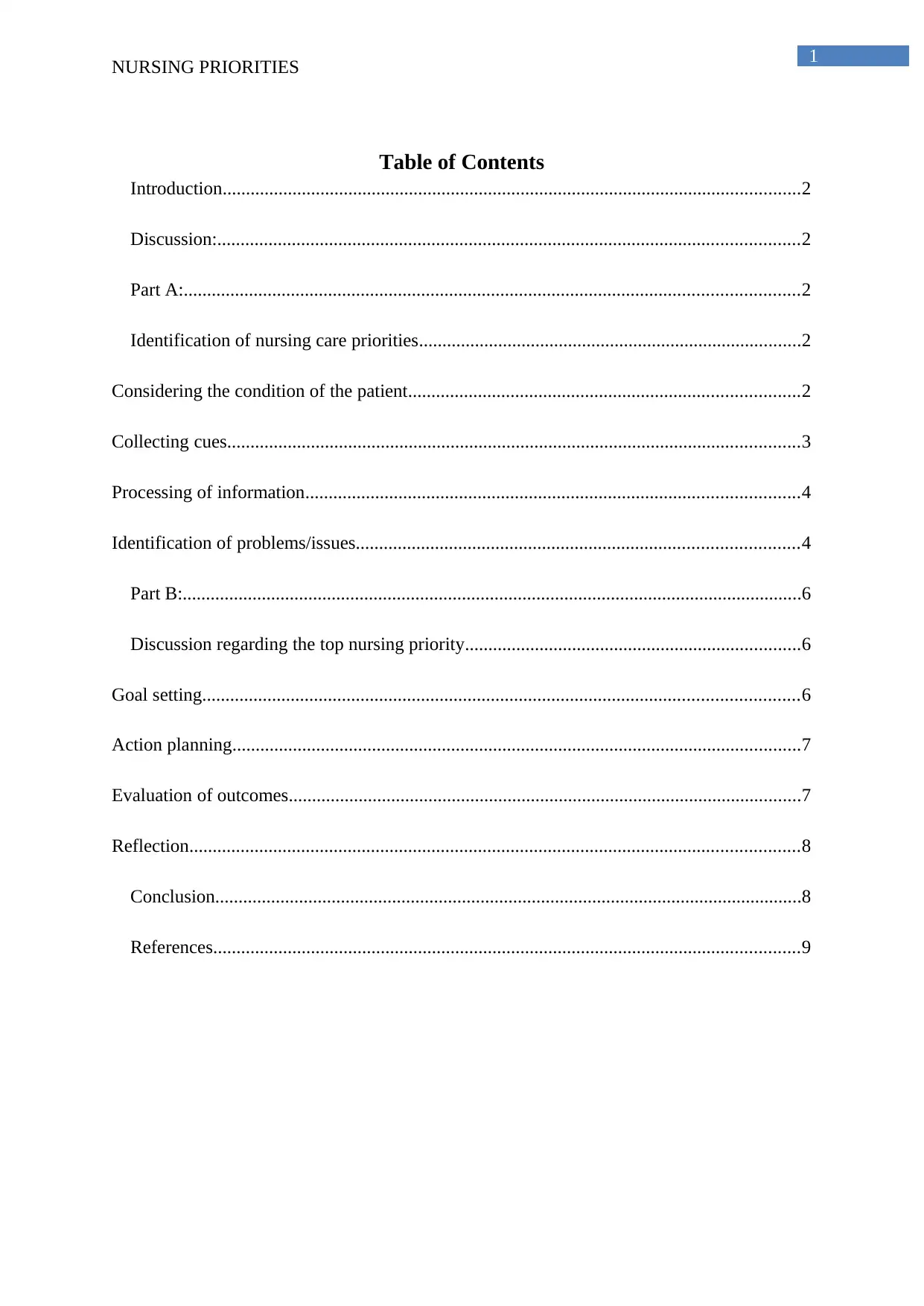
1
NURSING PRIORITIES
Table of Contents
Introduction............................................................................................................................2
Discussion:.............................................................................................................................2
Part A:....................................................................................................................................2
Identification of nursing care priorities..................................................................................2
Considering the condition of the patient....................................................................................2
Collecting cues...........................................................................................................................3
Processing of information..........................................................................................................4
Identification of problems/issues...............................................................................................4
Part B:.....................................................................................................................................6
Discussion regarding the top nursing priority........................................................................6
Goal setting................................................................................................................................6
Action planning..........................................................................................................................7
Evaluation of outcomes..............................................................................................................7
Reflection...................................................................................................................................8
Conclusion..............................................................................................................................8
References..............................................................................................................................9
NURSING PRIORITIES
Table of Contents
Introduction............................................................................................................................2
Discussion:.............................................................................................................................2
Part A:....................................................................................................................................2
Identification of nursing care priorities..................................................................................2
Considering the condition of the patient....................................................................................2
Collecting cues...........................................................................................................................3
Processing of information..........................................................................................................4
Identification of problems/issues...............................................................................................4
Part B:.....................................................................................................................................6
Discussion regarding the top nursing priority........................................................................6
Goal setting................................................................................................................................6
Action planning..........................................................................................................................7
Evaluation of outcomes..............................................................................................................7
Reflection...................................................................................................................................8
Conclusion..............................................................................................................................8
References..............................................................................................................................9
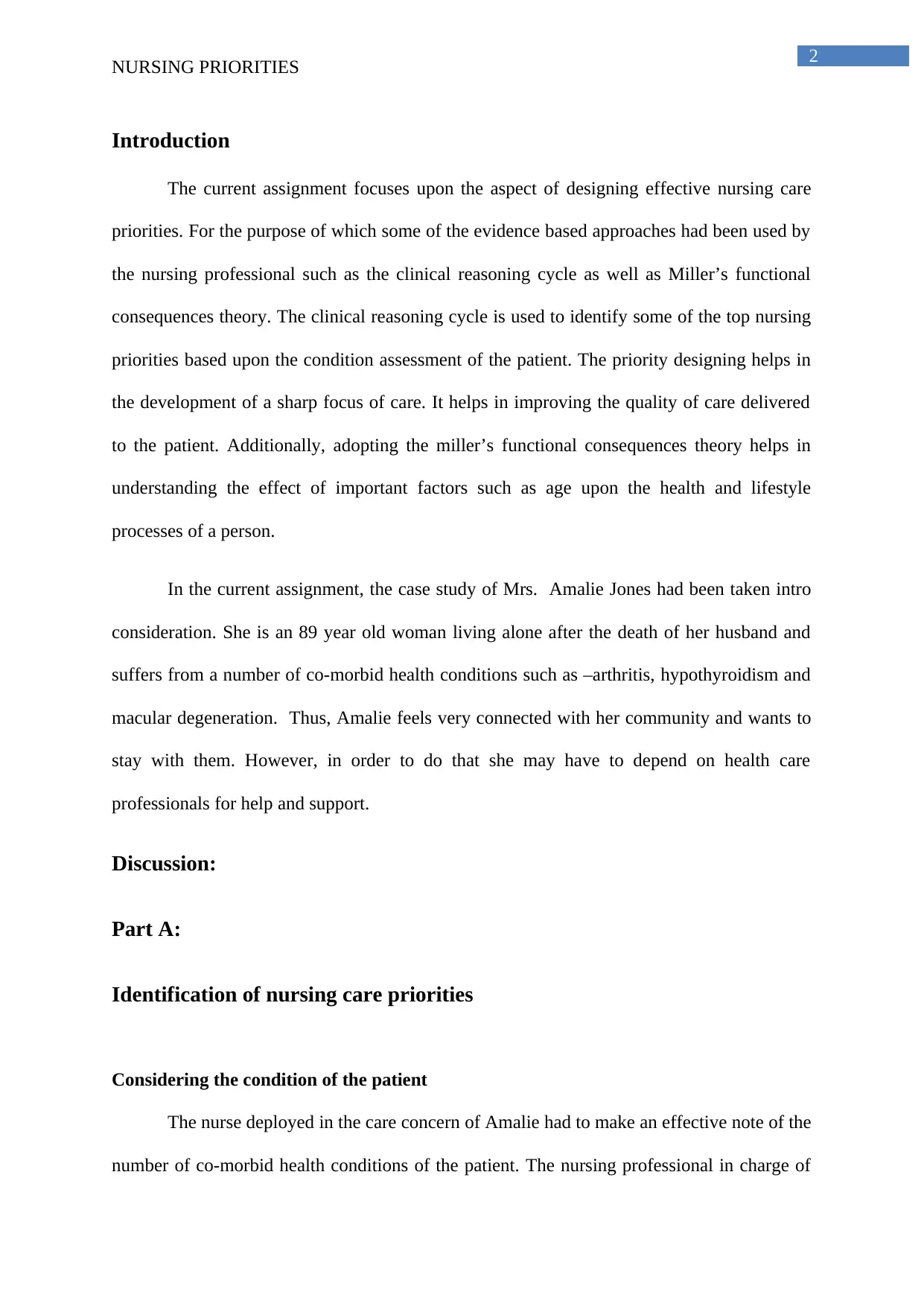
2
NURSING PRIORITIES
Introduction
The current assignment focuses upon the aspect of designing effective nursing care
priorities. For the purpose of which some of the evidence based approaches had been used by
the nursing professional such as the clinical reasoning cycle as well as Miller’s functional
consequences theory. The clinical reasoning cycle is used to identify some of the top nursing
priorities based upon the condition assessment of the patient. The priority designing helps in
the development of a sharp focus of care. It helps in improving the quality of care delivered
to the patient. Additionally, adopting the miller’s functional consequences theory helps in
understanding the effect of important factors such as age upon the health and lifestyle
processes of a person.
In the current assignment, the case study of Mrs. Amalie Jones had been taken intro
consideration. She is an 89 year old woman living alone after the death of her husband and
suffers from a number of co-morbid health conditions such as –arthritis, hypothyroidism and
macular degeneration. Thus, Amalie feels very connected with her community and wants to
stay with them. However, in order to do that she may have to depend on health care
professionals for help and support.
Discussion:
Part A:
Identification of nursing care priorities
Considering the condition of the patient
The nurse deployed in the care concern of Amalie had to make an effective note of the
number of co-morbid health conditions of the patient. The nursing professional in charge of
NURSING PRIORITIES
Introduction
The current assignment focuses upon the aspect of designing effective nursing care
priorities. For the purpose of which some of the evidence based approaches had been used by
the nursing professional such as the clinical reasoning cycle as well as Miller’s functional
consequences theory. The clinical reasoning cycle is used to identify some of the top nursing
priorities based upon the condition assessment of the patient. The priority designing helps in
the development of a sharp focus of care. It helps in improving the quality of care delivered
to the patient. Additionally, adopting the miller’s functional consequences theory helps in
understanding the effect of important factors such as age upon the health and lifestyle
processes of a person.
In the current assignment, the case study of Mrs. Amalie Jones had been taken intro
consideration. She is an 89 year old woman living alone after the death of her husband and
suffers from a number of co-morbid health conditions such as –arthritis, hypothyroidism and
macular degeneration. Thus, Amalie feels very connected with her community and wants to
stay with them. However, in order to do that she may have to depend on health care
professionals for help and support.
Discussion:
Part A:
Identification of nursing care priorities
Considering the condition of the patient
The nurse deployed in the care concern of Amalie had to make an effective note of the
number of co-morbid health conditions of the patient. The nursing professional in charge of
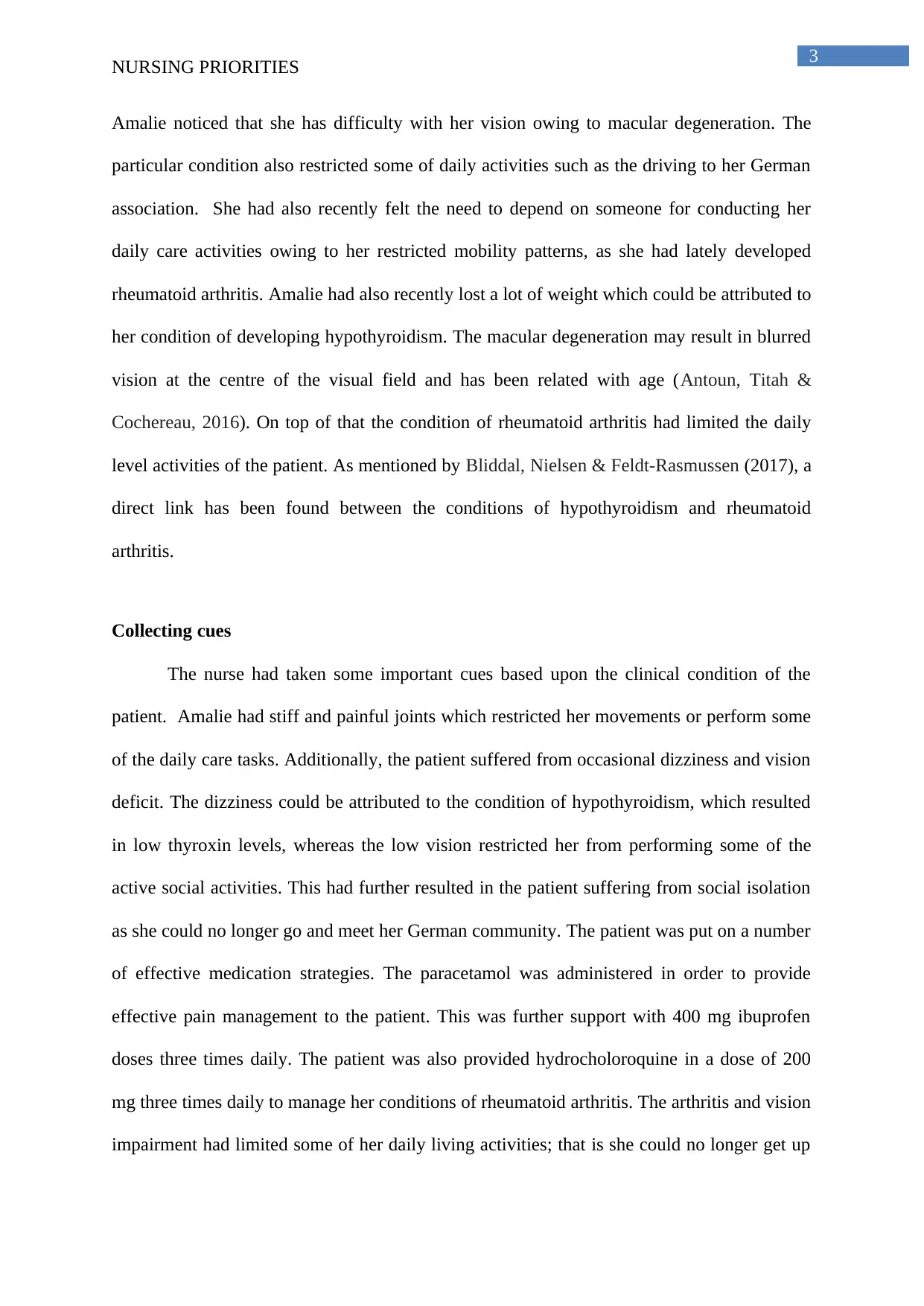
3
NURSING PRIORITIES
Amalie noticed that she has difficulty with her vision owing to macular degeneration. The
particular condition also restricted some of daily activities such as the driving to her German
association. She had also recently felt the need to depend on someone for conducting her
daily care activities owing to her restricted mobility patterns, as she had lately developed
rheumatoid arthritis. Amalie had also recently lost a lot of weight which could be attributed to
her condition of developing hypothyroidism. The macular degeneration may result in blurred
vision at the centre of the visual field and has been related with age (Antoun, Titah &
Cochereau, 2016). On top of that the condition of rheumatoid arthritis had limited the daily
level activities of the patient. As mentioned by Bliddal, Nielsen & Feldt-Rasmussen (2017), a
direct link has been found between the conditions of hypothyroidism and rheumatoid
arthritis.
Collecting cues
The nurse had taken some important cues based upon the clinical condition of the
patient. Amalie had stiff and painful joints which restricted her movements or perform some
of the daily care tasks. Additionally, the patient suffered from occasional dizziness and vision
deficit. The dizziness could be attributed to the condition of hypothyroidism, which resulted
in low thyroxin levels, whereas the low vision restricted her from performing some of the
active social activities. This had further resulted in the patient suffering from social isolation
as she could no longer go and meet her German community. The patient was put on a number
of effective medication strategies. The paracetamol was administered in order to provide
effective pain management to the patient. This was further support with 400 mg ibuprofen
doses three times daily. The patient was also provided hydrocholoroquine in a dose of 200
mg three times daily to manage her conditions of rheumatoid arthritis. The arthritis and vision
impairment had limited some of her daily living activities; that is she could no longer get up
NURSING PRIORITIES
Amalie noticed that she has difficulty with her vision owing to macular degeneration. The
particular condition also restricted some of daily activities such as the driving to her German
association. She had also recently felt the need to depend on someone for conducting her
daily care activities owing to her restricted mobility patterns, as she had lately developed
rheumatoid arthritis. Amalie had also recently lost a lot of weight which could be attributed to
her condition of developing hypothyroidism. The macular degeneration may result in blurred
vision at the centre of the visual field and has been related with age (Antoun, Titah &
Cochereau, 2016). On top of that the condition of rheumatoid arthritis had limited the daily
level activities of the patient. As mentioned by Bliddal, Nielsen & Feldt-Rasmussen (2017), a
direct link has been found between the conditions of hypothyroidism and rheumatoid
arthritis.
Collecting cues
The nurse had taken some important cues based upon the clinical condition of the
patient. Amalie had stiff and painful joints which restricted her movements or perform some
of the daily care tasks. Additionally, the patient suffered from occasional dizziness and vision
deficit. The dizziness could be attributed to the condition of hypothyroidism, which resulted
in low thyroxin levels, whereas the low vision restricted her from performing some of the
active social activities. This had further resulted in the patient suffering from social isolation
as she could no longer go and meet her German community. The patient was put on a number
of effective medication strategies. The paracetamol was administered in order to provide
effective pain management to the patient. This was further support with 400 mg ibuprofen
doses three times daily. The patient was also provided hydrocholoroquine in a dose of 200
mg three times daily to manage her conditions of rheumatoid arthritis. The arthritis and vision
impairment had limited some of her daily living activities; that is she could no longer get up
Secure Best Marks with AI Grader
Need help grading? Try our AI Grader for instant feedback on your assignments.

4
NURSING PRIORITIES
and cook food for herself. Additionally, she suffered from social isolation owing to her
physical disabilities which could further develop depression within the patient. As
commented by Malaviya (2016), the lower levels of thyroxin could further worsen her
condition of rheumatoid arthritis by triggering the autoimmune form of the disease.
Processing of information
The patient had lately developed hypothyroidism resulting in loss of weight. The
hypothyroidism could have developed as an autoimmune disorder and could be related
significantly to the development of the Rheumatoid arthritis. As mentioned by Bliddal,
Nielsen & Feldt-Rasmussen (2017), the rheumatoid arthritis have been seen to affect the
immune cells of the body considerably. Under these conditions, the body treats the thyroid
glands and its products as threats. Therefore, producing anrtibodies against the own body’s
cells and tissues. As reported by Malaviya (2016), rheumatoid arthritis has been linked with
menopause and hormonal changes in women. Hence, there is greater propensity for the
development of rheumatoid arthritis after menopause.
Identification of problems/issues
Therefore, based upon the issue identification a number of effective nursing
interventions could be designed over here which are-pain management, medication
management and support through counselling activities.
Pain management
Amalie had been complaining of stiffness and pain around the joints. Therefore,
implementing light exercises for the patient would have helped in the revival of free muscle
movement in the patient. As reported by Jones, Hamilton & Murry (2015), it is important to
move in rheumatoid arthritis, as exercises have been seen to reduce the amount of pain
NURSING PRIORITIES
and cook food for herself. Additionally, she suffered from social isolation owing to her
physical disabilities which could further develop depression within the patient. As
commented by Malaviya (2016), the lower levels of thyroxin could further worsen her
condition of rheumatoid arthritis by triggering the autoimmune form of the disease.
Processing of information
The patient had lately developed hypothyroidism resulting in loss of weight. The
hypothyroidism could have developed as an autoimmune disorder and could be related
significantly to the development of the Rheumatoid arthritis. As mentioned by Bliddal,
Nielsen & Feldt-Rasmussen (2017), the rheumatoid arthritis have been seen to affect the
immune cells of the body considerably. Under these conditions, the body treats the thyroid
glands and its products as threats. Therefore, producing anrtibodies against the own body’s
cells and tissues. As reported by Malaviya (2016), rheumatoid arthritis has been linked with
menopause and hormonal changes in women. Hence, there is greater propensity for the
development of rheumatoid arthritis after menopause.
Identification of problems/issues
Therefore, based upon the issue identification a number of effective nursing
interventions could be designed over here which are-pain management, medication
management and support through counselling activities.
Pain management
Amalie had been complaining of stiffness and pain around the joints. Therefore,
implementing light exercises for the patient would have helped in the revival of free muscle
movement in the patient. As reported by Jones, Hamilton & Murry (2015), it is important to
move in rheumatoid arthritis, as exercises have been seen to reduce the amount of pain

5
NURSING PRIORITIES
experienced by the patient. As commented by Papastavrou, Andreou & Efstathiou (2014),
light to moderate exercises have been seen to prevent muscle wasting. Amalie should be
helped by the nursing professional in managing her movements. The agility in the patient
could be restored with the help of stretching and weight training exercises (Liou et al., 2016).
Impaired mobility in the patient
In this case, the patient had movement restrictions owing to stiff and swollen joints,
which further affected the activities for daily living (ADL) of the patient. Amalie was
suffering from acute pain owing to rheumatoid arthritis, which further made moving around
difficult for her, as the moment she would try to make movements her joints would wretch.
However, in order to help the patient with the mobility patterns they could be provided with
an aid such as walking sticks. Additionally, inculcation of light exercises in the daily routine
of the patient can also help in easing the movement discomforts and revive mobility in the
patient (Fletcher & Meyer, 2016). Due to the movement disabilities of the patient medication
management also becomes an issue where the medicines will be placed at a lower level close
to the bed so that the patient can easily take them.
Social exclusion
The patient had also been living alone and due to her poor vision has lost connection
with outside world as she could not drive to the German centre. Additionally, she considered
herself a burden on her family secluding herself. Hence, it was required that she be provided
with effective counselling and daily support care, which could reduce the feelings of
depression and helplessness in the patient (Yardley, Morrison, Bradbury & Muller, 2015).
The nursing professional cam use millers’ functional consequences theory for
wellness promotion in the patient by fostering a sense of value and dignity within the patient
NURSING PRIORITIES
experienced by the patient. As commented by Papastavrou, Andreou & Efstathiou (2014),
light to moderate exercises have been seen to prevent muscle wasting. Amalie should be
helped by the nursing professional in managing her movements. The agility in the patient
could be restored with the help of stretching and weight training exercises (Liou et al., 2016).
Impaired mobility in the patient
In this case, the patient had movement restrictions owing to stiff and swollen joints,
which further affected the activities for daily living (ADL) of the patient. Amalie was
suffering from acute pain owing to rheumatoid arthritis, which further made moving around
difficult for her, as the moment she would try to make movements her joints would wretch.
However, in order to help the patient with the mobility patterns they could be provided with
an aid such as walking sticks. Additionally, inculcation of light exercises in the daily routine
of the patient can also help in easing the movement discomforts and revive mobility in the
patient (Fletcher & Meyer, 2016). Due to the movement disabilities of the patient medication
management also becomes an issue where the medicines will be placed at a lower level close
to the bed so that the patient can easily take them.
Social exclusion
The patient had also been living alone and due to her poor vision has lost connection
with outside world as she could not drive to the German centre. Additionally, she considered
herself a burden on her family secluding herself. Hence, it was required that she be provided
with effective counselling and daily support care, which could reduce the feelings of
depression and helplessness in the patient (Yardley, Morrison, Bradbury & Muller, 2015).
The nursing professional cam use millers’ functional consequences theory for
wellness promotion in the patient by fostering a sense of value and dignity within the patient
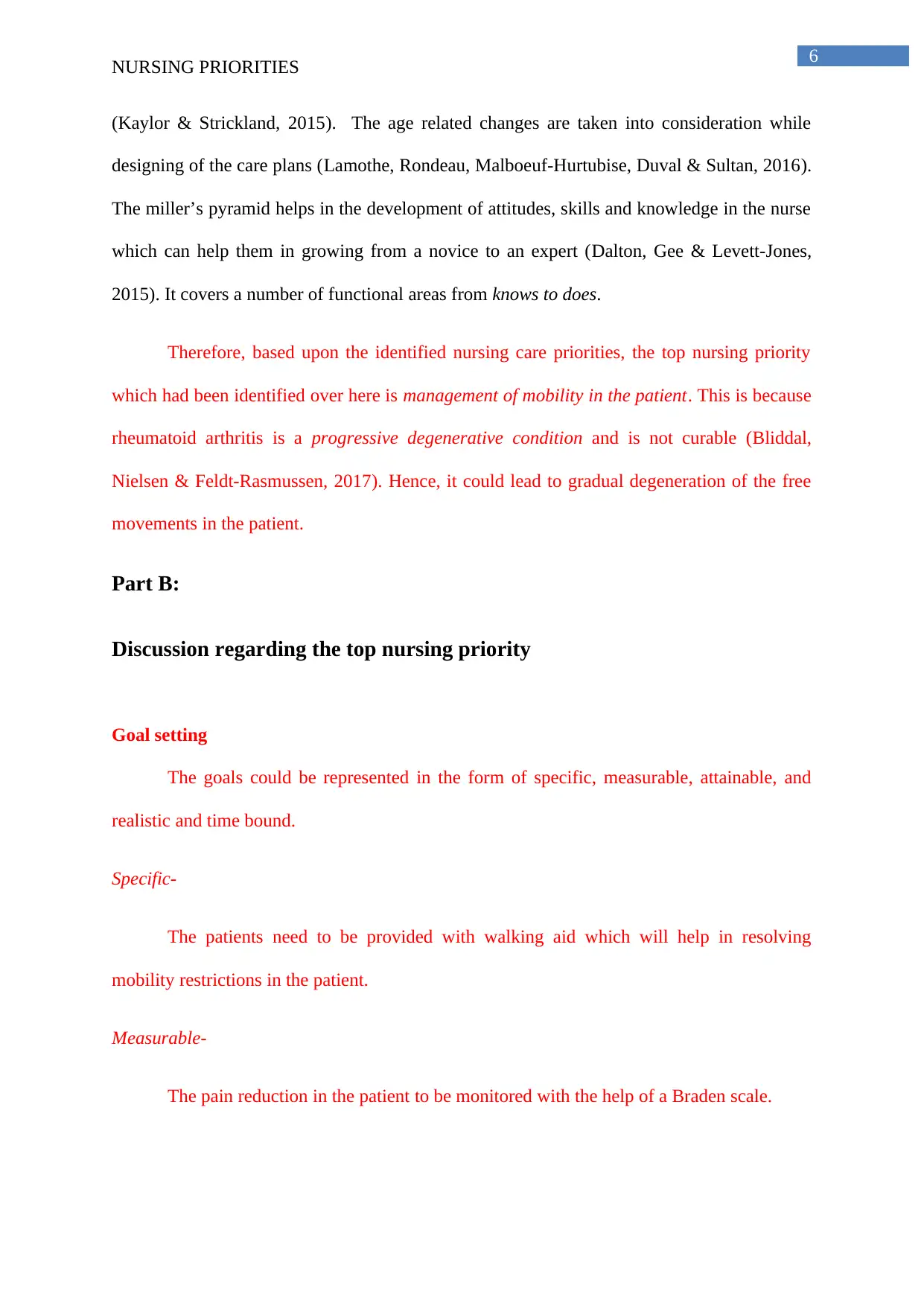
6
NURSING PRIORITIES
(Kaylor & Strickland, 2015). The age related changes are taken into consideration while
designing of the care plans (Lamothe, Rondeau, Malboeuf-Hurtubise, Duval & Sultan, 2016).
The miller’s pyramid helps in the development of attitudes, skills and knowledge in the nurse
which can help them in growing from a novice to an expert (Dalton, Gee & Levett-Jones,
2015). It covers a number of functional areas from knows to does.
Therefore, based upon the identified nursing care priorities, the top nursing priority
which had been identified over here is management of mobility in the patient. This is because
rheumatoid arthritis is a progressive degenerative condition and is not curable (Bliddal,
Nielsen & Feldt-Rasmussen, 2017). Hence, it could lead to gradual degeneration of the free
movements in the patient.
Part B:
Discussion regarding the top nursing priority
Goal setting
The goals could be represented in the form of specific, measurable, attainable, and
realistic and time bound.
Specific-
The patients need to be provided with walking aid which will help in resolving
mobility restrictions in the patient.
Measurable-
The pain reduction in the patient to be monitored with the help of a Braden scale.
NURSING PRIORITIES
(Kaylor & Strickland, 2015). The age related changes are taken into consideration while
designing of the care plans (Lamothe, Rondeau, Malboeuf-Hurtubise, Duval & Sultan, 2016).
The miller’s pyramid helps in the development of attitudes, skills and knowledge in the nurse
which can help them in growing from a novice to an expert (Dalton, Gee & Levett-Jones,
2015). It covers a number of functional areas from knows to does.
Therefore, based upon the identified nursing care priorities, the top nursing priority
which had been identified over here is management of mobility in the patient. This is because
rheumatoid arthritis is a progressive degenerative condition and is not curable (Bliddal,
Nielsen & Feldt-Rasmussen, 2017). Hence, it could lead to gradual degeneration of the free
movements in the patient.
Part B:
Discussion regarding the top nursing priority
Goal setting
The goals could be represented in the form of specific, measurable, attainable, and
realistic and time bound.
Specific-
The patients need to be provided with walking aid which will help in resolving
mobility restrictions in the patient.
Measurable-
The pain reduction in the patient to be monitored with the help of a Braden scale.
Paraphrase This Document
Need a fresh take? Get an instant paraphrase of this document with our AI Paraphraser

7
NURSING PRIORITIES
Attainable-
The patient to gain control over her body movement patterns with the help of
indulgence in light exercises. The patient to be involved in community based exercise and
intervention methods.
Realistic-
An improvement in the mobility patterns of the patient to be monitored through
gradual physical training.
Time-bound-
The entire process to be achieved in a three months time.
Action planning
Some of the nursing interventions which could be implemented for the condition
management of the patient have been further discussed. The patient could be helped to
resolve the issues of restricted movements by providing her with a walking aid. The pain the
patient could be measured with the help of a Braden scale. The patient to be further referred
the patient to an orthopaedic in case of aggravated symptoms, where the patient could be
referred to a physiotherapist for regulation of joint stiffness and pain management. The
assessment for activities of daily living (ADL) should be conducted of the patient and in turn
carer could be deployed to help the patient with her ADL (LoBiondo-Wood & Haber, 2017).
A fall risk assessment could be conducted for Amalie as she lives alone and had recently
developed macular degeneration. Hence, she was at a higher risk of fall.
NURSING PRIORITIES
Attainable-
The patient to gain control over her body movement patterns with the help of
indulgence in light exercises. The patient to be involved in community based exercise and
intervention methods.
Realistic-
An improvement in the mobility patterns of the patient to be monitored through
gradual physical training.
Time-bound-
The entire process to be achieved in a three months time.
Action planning
Some of the nursing interventions which could be implemented for the condition
management of the patient have been further discussed. The patient could be helped to
resolve the issues of restricted movements by providing her with a walking aid. The pain the
patient could be measured with the help of a Braden scale. The patient to be further referred
the patient to an orthopaedic in case of aggravated symptoms, where the patient could be
referred to a physiotherapist for regulation of joint stiffness and pain management. The
assessment for activities of daily living (ADL) should be conducted of the patient and in turn
carer could be deployed to help the patient with her ADL (LoBiondo-Wood & Haber, 2017).
A fall risk assessment could be conducted for Amalie as she lives alone and had recently
developed macular degeneration. Hence, she was at a higher risk of fall.

8
NURSING PRIORITIES
Evaluation of outcomes
The evaluation of the outcomes can further help in understanding the success of the
applied nursing interventions. Some of these have been noted in order to analyse the
recovery rate of the patient. On successful dissemination of the nursing intervention it was
seen that Amalie was able to move more easily and expressed less pain while moving .She
depicted more confidence in managing her daily activities by self. She also depicted more
autonomy in managing her daily care activities and was hopeful regarding getting well and
looked forward to meeting her family.
Reflection
From my nursing care experiences of Amalie, I have realized that application of a
person centred approach would have helped me in understanding the care concerns of the
patient better. The patient here suffered from a number of co-morbid conditions such as
hypothyroidism, rheumatoid arthritis and macular degeneration. Therefore, the patient had
lost her control over her ADLs. This made the patient morose; hence, I felt the need to
connect with the patient on a personal level. Therefore, using therapeutic communication
approaches would have helped me in understanding the grievances of the patient.
Additionally, the nursing exposure with Amalie also helped me to excel at making effective
clinical related decisions using evidence based methods.
Conclusion
The current assignment discusses the nursing car priorities for a patient with a number
of co-morbid health conditions. Therefore, it was necessary to develop an effective and
nursing care plan for the patient. A number of nursing care priorities had been designed for
the patient. In this respect, Amalie had to suffer from acute pain owing to rheumatoid
arthritis. The joint stiffness allowed her with little freedom for physical movement.
NURSING PRIORITIES
Evaluation of outcomes
The evaluation of the outcomes can further help in understanding the success of the
applied nursing interventions. Some of these have been noted in order to analyse the
recovery rate of the patient. On successful dissemination of the nursing intervention it was
seen that Amalie was able to move more easily and expressed less pain while moving .She
depicted more confidence in managing her daily activities by self. She also depicted more
autonomy in managing her daily care activities and was hopeful regarding getting well and
looked forward to meeting her family.
Reflection
From my nursing care experiences of Amalie, I have realized that application of a
person centred approach would have helped me in understanding the care concerns of the
patient better. The patient here suffered from a number of co-morbid conditions such as
hypothyroidism, rheumatoid arthritis and macular degeneration. Therefore, the patient had
lost her control over her ADLs. This made the patient morose; hence, I felt the need to
connect with the patient on a personal level. Therefore, using therapeutic communication
approaches would have helped me in understanding the grievances of the patient.
Additionally, the nursing exposure with Amalie also helped me to excel at making effective
clinical related decisions using evidence based methods.
Conclusion
The current assignment discusses the nursing car priorities for a patient with a number
of co-morbid health conditions. Therefore, it was necessary to develop an effective and
nursing care plan for the patient. A number of nursing care priorities had been designed for
the patient. In this respect, Amalie had to suffer from acute pain owing to rheumatoid
arthritis. The joint stiffness allowed her with little freedom for physical movement.
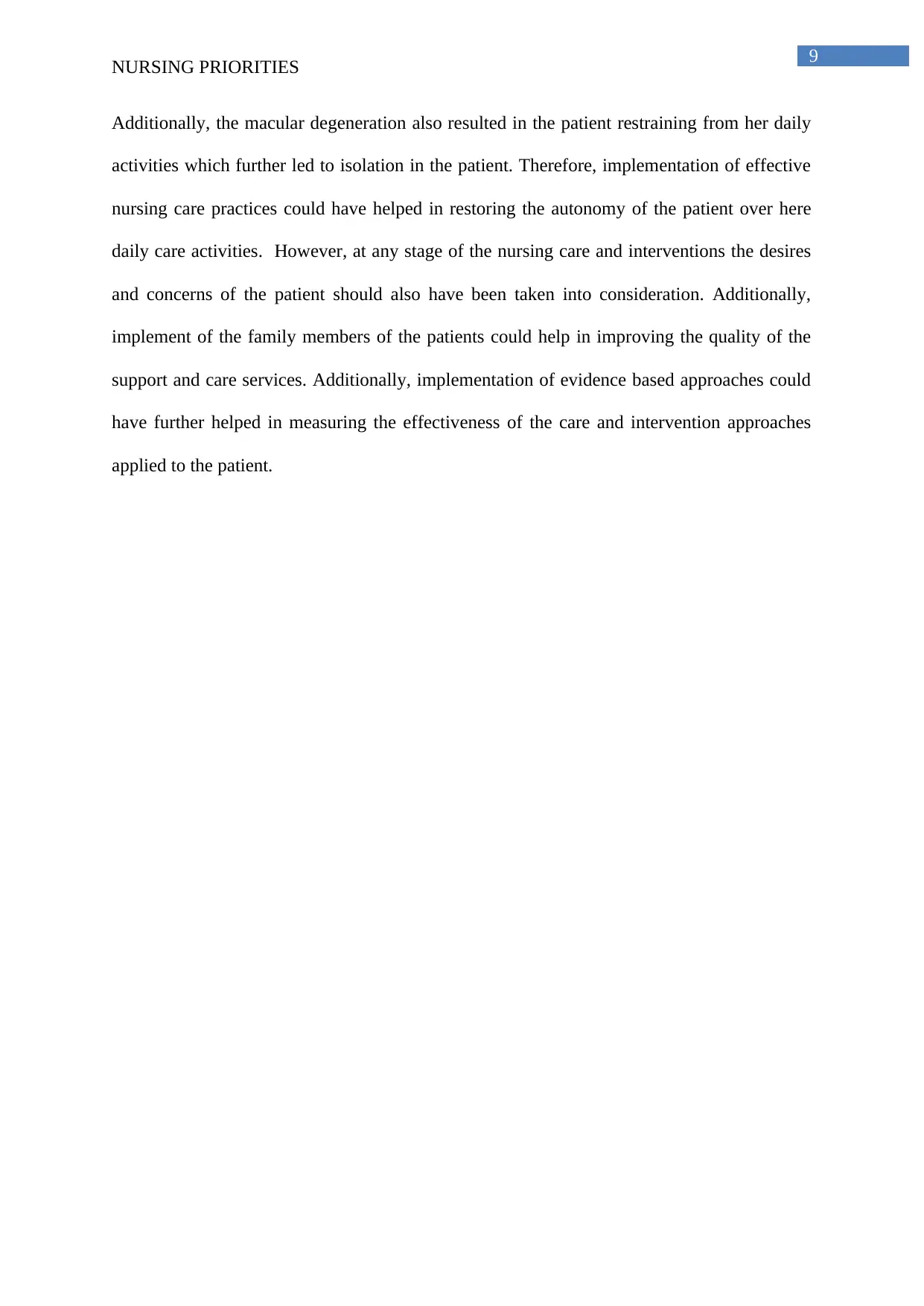
9
NURSING PRIORITIES
Additionally, the macular degeneration also resulted in the patient restraining from her daily
activities which further led to isolation in the patient. Therefore, implementation of effective
nursing care practices could have helped in restoring the autonomy of the patient over here
daily care activities. However, at any stage of the nursing care and interventions the desires
and concerns of the patient should also have been taken into consideration. Additionally,
implement of the family members of the patients could help in improving the quality of the
support and care services. Additionally, implementation of evidence based approaches could
have further helped in measuring the effectiveness of the care and intervention approaches
applied to the patient.
NURSING PRIORITIES
Additionally, the macular degeneration also resulted in the patient restraining from her daily
activities which further led to isolation in the patient. Therefore, implementation of effective
nursing care practices could have helped in restoring the autonomy of the patient over here
daily care activities. However, at any stage of the nursing care and interventions the desires
and concerns of the patient should also have been taken into consideration. Additionally,
implement of the family members of the patients could help in improving the quality of the
support and care services. Additionally, implementation of evidence based approaches could
have further helped in measuring the effectiveness of the care and intervention approaches
applied to the patient.
Secure Best Marks with AI Grader
Need help grading? Try our AI Grader for instant feedback on your assignments.

10
NURSING PRIORITIES
References
Antoun, J., Titah, C., & Cochereau, I. (2016). Ocular and orbital side-effects of checkpoint
inhibitors: a review article. Current opinion in oncology, 28(4), 288-294.
Bliddal, S., Nielsen, C. H., & Feldt-Rasmussen, U. (2017). Recent advances in understanding
autoimmune thyroid disease: the tallest tree in the forest of
polyautoimmunity. F1000Research, 6, 25-45.
Dalton, L., Gee, T., & Levett-Jones, T. (2015). Using clinical reasoning and simulation-based
education to'flip'the Enrolled Nurse curriculum. Australian Journal of Advanced
Nursing, The, 33(2), 29.
Fletcher, K. A., & Meyer, M. (2016). Coaching model, clinical playbook, transformative
learning. Journal of Professional Nursing, 32(2), 121-129.
Jones, T. L., Hamilton, P., & Murry, N. (2015). Unfinished nursing care, missed care, and
implicitly rationed care: State of the science review. International journal of nursing
studies, 52(6), 1121-1137.
Kaylor, S. K., & Strickland, H. P. (2015). Unfolding case studies as a formative teaching
methodology for novice nursing students. Journal of Nursing Education, 55-67.
Lamothe, M., Rondeau, É., Malboeuf-Hurtubise, C., Duval, M., & Sultan, S. (2016).
Outcomes of MBSR or MBSR-based interventions in health care providers: A
systematic review with a focus on empathy and emotional
competencies. Complementary therapies in medicine, 24, 19-28.
NURSING PRIORITIES
References
Antoun, J., Titah, C., & Cochereau, I. (2016). Ocular and orbital side-effects of checkpoint
inhibitors: a review article. Current opinion in oncology, 28(4), 288-294.
Bliddal, S., Nielsen, C. H., & Feldt-Rasmussen, U. (2017). Recent advances in understanding
autoimmune thyroid disease: the tallest tree in the forest of
polyautoimmunity. F1000Research, 6, 25-45.
Dalton, L., Gee, T., & Levett-Jones, T. (2015). Using clinical reasoning and simulation-based
education to'flip'the Enrolled Nurse curriculum. Australian Journal of Advanced
Nursing, The, 33(2), 29.
Fletcher, K. A., & Meyer, M. (2016). Coaching model, clinical playbook, transformative
learning. Journal of Professional Nursing, 32(2), 121-129.
Jones, T. L., Hamilton, P., & Murry, N. (2015). Unfinished nursing care, missed care, and
implicitly rationed care: State of the science review. International journal of nursing
studies, 52(6), 1121-1137.
Kaylor, S. K., & Strickland, H. P. (2015). Unfolding case studies as a formative teaching
methodology for novice nursing students. Journal of Nursing Education, 55-67.
Lamothe, M., Rondeau, É., Malboeuf-Hurtubise, C., Duval, M., & Sultan, S. (2016).
Outcomes of MBSR or MBSR-based interventions in health care providers: A
systematic review with a focus on empathy and emotional
competencies. Complementary therapies in medicine, 24, 19-28.
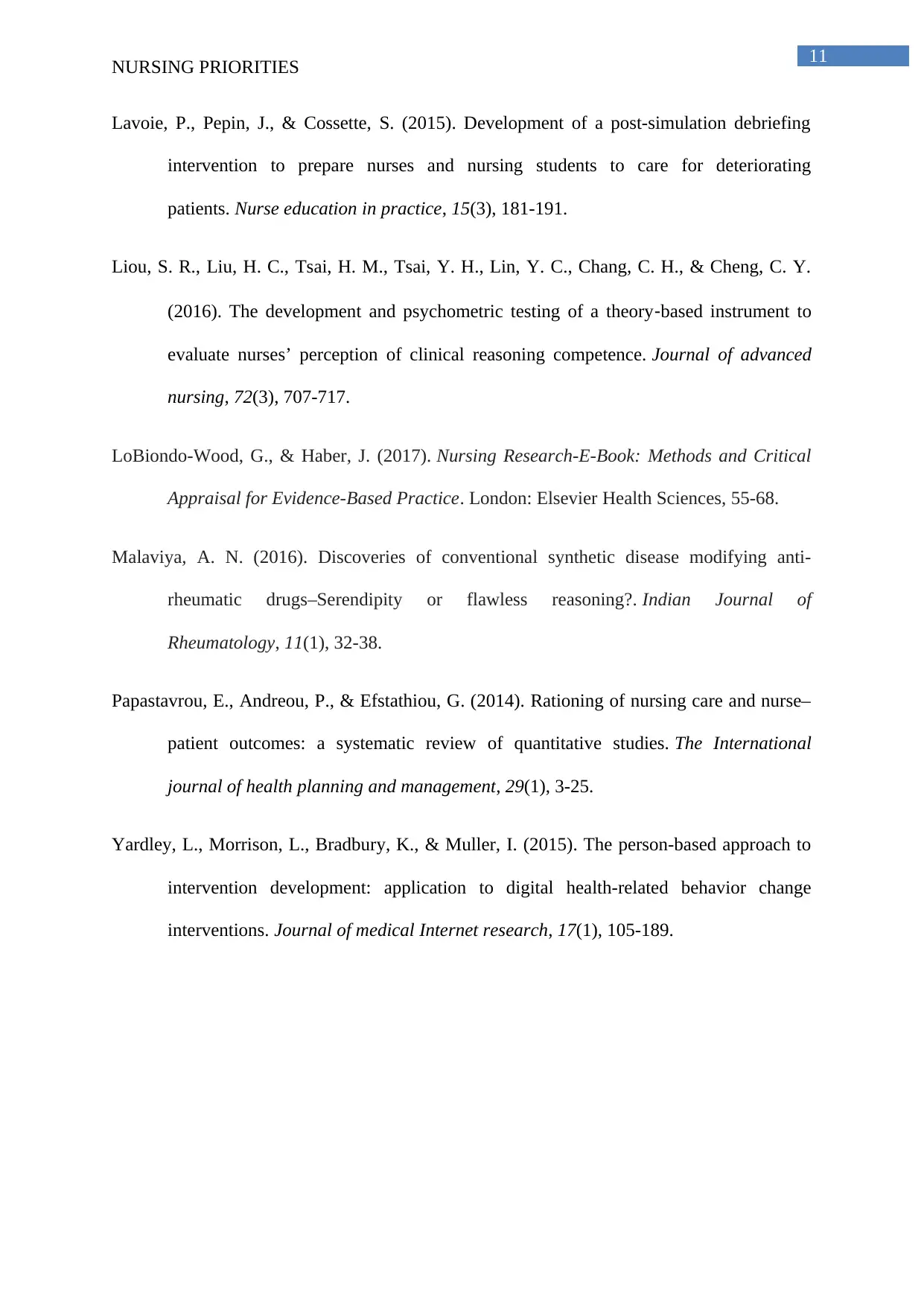
11
NURSING PRIORITIES
Lavoie, P., Pepin, J., & Cossette, S. (2015). Development of a post-simulation debriefing
intervention to prepare nurses and nursing students to care for deteriorating
patients. Nurse education in practice, 15(3), 181-191.
Liou, S. R., Liu, H. C., Tsai, H. M., Tsai, Y. H., Lin, Y. C., Chang, C. H., & Cheng, C. Y.
(2016). The development and psychometric testing of a theory‐based instrument to
evaluate nurses’ perception of clinical reasoning competence. Journal of advanced
nursing, 72(3), 707-717.
LoBiondo-Wood, G., & Haber, J. (2017). Nursing Research-E-Book: Methods and Critical
Appraisal for Evidence-Based Practice. London: Elsevier Health Sciences, 55-68.
Malaviya, A. N. (2016). Discoveries of conventional synthetic disease modifying anti-
rheumatic drugs–Serendipity or flawless reasoning?. Indian Journal of
Rheumatology, 11(1), 32-38.
Papastavrou, E., Andreou, P., & Efstathiou, G. (2014). Rationing of nursing care and nurse–
patient outcomes: a systematic review of quantitative studies. The International
journal of health planning and management, 29(1), 3-25.
Yardley, L., Morrison, L., Bradbury, K., & Muller, I. (2015). The person-based approach to
intervention development: application to digital health-related behavior change
interventions. Journal of medical Internet research, 17(1), 105-189.
NURSING PRIORITIES
Lavoie, P., Pepin, J., & Cossette, S. (2015). Development of a post-simulation debriefing
intervention to prepare nurses and nursing students to care for deteriorating
patients. Nurse education in practice, 15(3), 181-191.
Liou, S. R., Liu, H. C., Tsai, H. M., Tsai, Y. H., Lin, Y. C., Chang, C. H., & Cheng, C. Y.
(2016). The development and psychometric testing of a theory‐based instrument to
evaluate nurses’ perception of clinical reasoning competence. Journal of advanced
nursing, 72(3), 707-717.
LoBiondo-Wood, G., & Haber, J. (2017). Nursing Research-E-Book: Methods and Critical
Appraisal for Evidence-Based Practice. London: Elsevier Health Sciences, 55-68.
Malaviya, A. N. (2016). Discoveries of conventional synthetic disease modifying anti-
rheumatic drugs–Serendipity or flawless reasoning?. Indian Journal of
Rheumatology, 11(1), 32-38.
Papastavrou, E., Andreou, P., & Efstathiou, G. (2014). Rationing of nursing care and nurse–
patient outcomes: a systematic review of quantitative studies. The International
journal of health planning and management, 29(1), 3-25.
Yardley, L., Morrison, L., Bradbury, K., & Muller, I. (2015). The person-based approach to
intervention development: application to digital health-related behavior change
interventions. Journal of medical Internet research, 17(1), 105-189.
1 out of 12
Related Documents
Your All-in-One AI-Powered Toolkit for Academic Success.
+13062052269
info@desklib.com
Available 24*7 on WhatsApp / Email
![[object Object]](/_next/static/media/star-bottom.7253800d.svg)
Unlock your academic potential
© 2024 | Zucol Services PVT LTD | All rights reserved.


